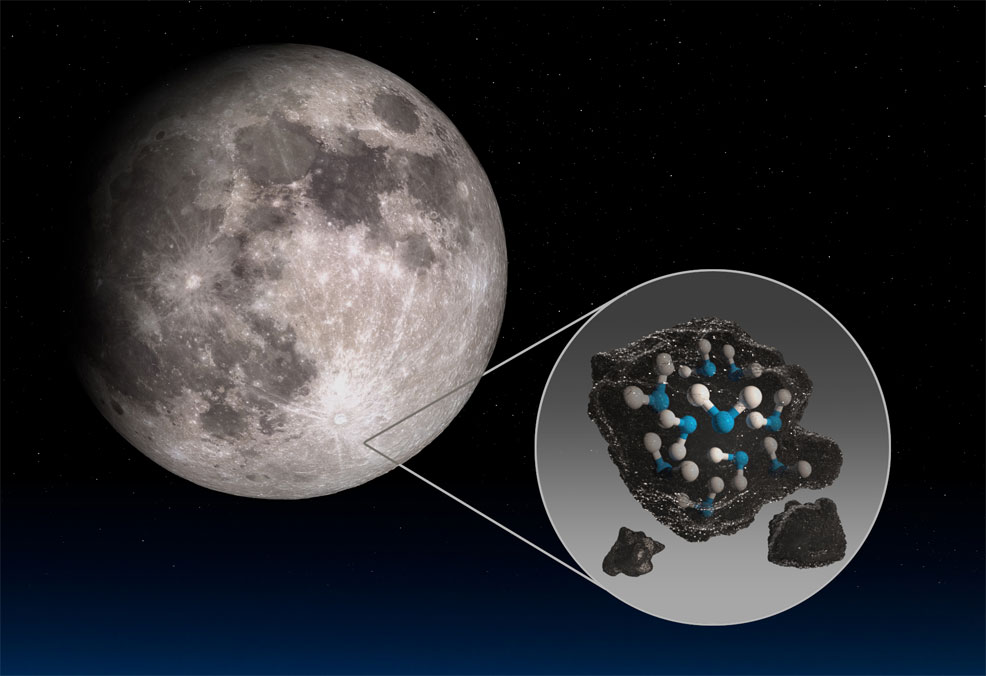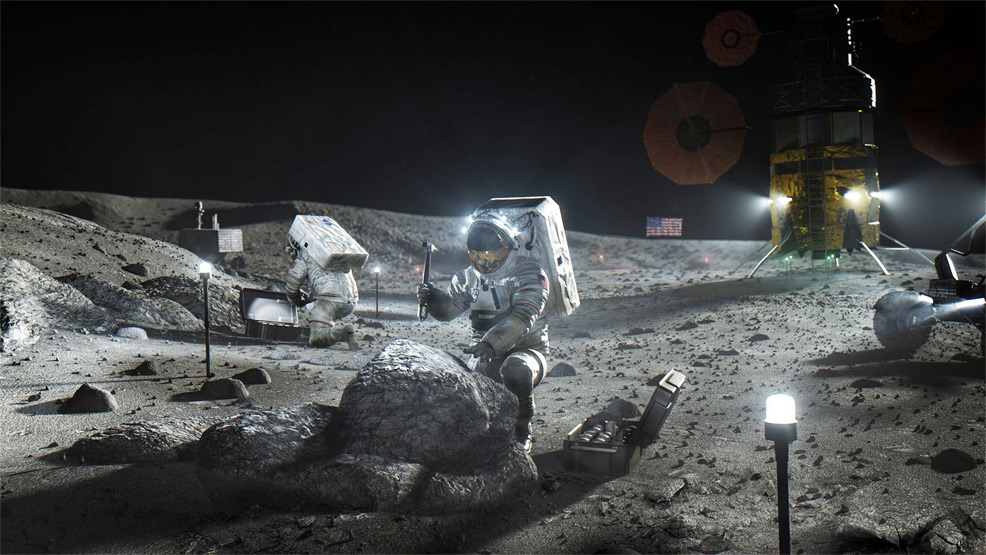
26th October 2020 Water discovered on sunlit surface of Moon Astronomers report detecting molecular water on the sunlit surface of the Moon, using the Stratospheric Observatory for Infrared Astronomy (SOFIA).
NASA's Stratospheric Observatory for Infrared Astronomy (SOFIA) has confirmed, for the first time, water on the sunlit surface of the Moon. This discovery indicates that water may be distributed across the lunar surface – and not limited to cold, shadowed places. SOFIA has detected water molecules (H2O) in Clavius Crater, one of the largest craters visible from Earth, and featured in the movie 2001: A Space Odyssey. Previous observations of the Moon's surface detected some form of hydrogen, but were unable to distinguish between water and its close chemical relative, hydroxyl (OH). Data from this location reveal water in concentrations of up to 412 parts per million – roughly equivalent to a 12-ounce bottle of water – trapped in a cubic metre of soil spread across the lunar surface. The results are published in the latest issue of Nature Astronomy. "We had indications that H2O – the familiar water we know – might be present on the sunlit side of the Moon," said Paul Hertz, director of the Astrophysics Division in the Science Mission Directorate at NASA Headquarters in Washington. "Now we know it is there. This discovery challenges our understanding of the lunar surface and raises intriguing questions about resources relevant for deep space exploration." By comparison, the Sahara desert has 100 times the amount of water detected in the lunar soil. Despite the relatively small amounts, it could prove to be an extremely valuable resource for crewed missions in the future – though whether it is easily accessible remains to be determined. Under NASA's Artemis program, the agency is eager to learn all it can about the presence of water on the Moon in advance of sending the first woman and next man to the lunar surface in 2024 and establishing a "sustainable human presence" there by the end of the decade.
SOFIA's results build on decades of previous research. During the Apollo era, the Moon was thought to be completely dry. However, orbital and impactor missions over the past 20 years, such as NASA's Lunar Crater Observation and Sensing Satellite, confirmed ice in permanently shadowed craters around the Moon's poles. Meanwhile, several spacecraft – including the Cassini mission and Deep Impact comet mission, as well as India's Chandrayaan-1 mission – and NASA's ground-based Infrared Telescope Facility, looked broadly across the lunar surface and found evidence of hydration in sunnier regions. Yet those missions were unable to definitively distinguish the form in which it was present – either H2O or OH. "Prior to the SOFIA observations, we knew there was some kind of hydration," explains Casey Honniball, the lead author of this new study. "But we didn't know how much, if any, was actually water molecules – like we drink every day – or something more like drain cleaner." SOFIA offered a new means of looking at the Moon. Flying at altitudes of up to 45,000 feet, this modified Boeing 747 jetliner with a 106" diameter telescope reaches above 99% of the water vapour in Earth's atmosphere to get a clearer view of the infrared universe. Using its Faint Object infraRed CAmera for the SOFIA Telescope (FORCAST), SOFIA was able to pick up the specific wavelength unique to water molecules – at 6.1 microns – and discovered a surprising concentration in sunny Clavius Crater. "Without a thick atmosphere, water on the sunlit lunar surface should just be lost to space," said Honniball, who is now a postdoctoral fellow at NASA's Goddard Space Flight Center in Greenbelt, Maryland. "Yet somehow we're seeing it. Something is generating the water, and something must be trapping it there." Micrometeorites raining down on the lunar surface, carrying small amounts of water, could deposit the water upon impact. Another possibility is a two-step process whereby the Sun's solar wind delivers hydrogen to the lunar surface, followed by a chemical reaction with oxygen-bearing minerals in the soil to create hydroxyl. Meanwhile, radiation from the bombardment of micrometeorites could be transforming that hydroxyl into water. How the water then gets stored – making it possible to accumulate – also raises some intriguing questions. The water could be trapped into tiny beadlike structures in the soil that form out of the high heat created by micrometeorite impacts. Another possibility is that the water could be hidden between grains of lunar soil and sheltered from the sunlight – potentially making it more accessible than water trapped in beadlike structures. SOFIA's follow-up flights will look for water in additional sunlit locations and during different lunar phases to learn more about how the water is produced, stored, and moved across the Moon. This data will add to the work of future Moon missions, such as NASA's Volatiles Investigating Polar Exploration Rover (VIPER), to create the first water resource maps of the Moon for future human space exploration.
--- Follow us: Twitter | Facebook | Instagram | YouTube
Comments »
If you enjoyed this article, please consider sharing it:
|








